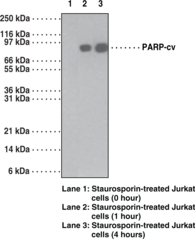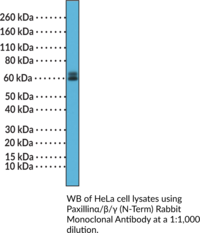Cayman
Showing 34051–34200 of 45550 results
-
PAR4 (1-6) is a peptide agonist of proteinase-activated receptor 4 (PAR4) that corresponds to residues 1-6 of the amino terminal tethered ligand sequence of human PAR4 and residues 48-53 of the full-length sequence.{47423} It activates PAR4 and the cleavage site mutant PAR4R47A when used at a concentration of 500 µM.{47424} PAR4 (1-6) induces platelet aggregation of isolated washed human platelets when used at a concentration of 1 mM but does not affect clotting time induced by factor VIIa, soluble tissue factor, and collagen in an ex vivo coagulation assay.{47425}
Brand:CaymanSKU:27126 - 10 mgAvailable on backorder
PAR4 (1-6) is a peptide agonist of proteinase-activated receptor 4 (PAR4) that corresponds to residues 1-6 of the amino terminal tethered ligand sequence of human PAR4 and residues 48-53 of the full-length sequence.{47423} It activates PAR4 and the cleavage site mutant PAR4R47A when used at a concentration of 500 µM.{47424} PAR4 (1-6) induces platelet aggregation of isolated washed human platelets when used at a concentration of 1 mM but does not affect clotting time induced by factor VIIa, soluble tissue factor, and collagen in an ex vivo coagulation assay.{47425}
Brand:CaymanSKU:27126 - 25 mgAvailable on backorder
PAR4 (1-6) is a peptide agonist of proteinase-activated receptor 4 (PAR4) that corresponds to residues 1-6 of the amino terminal tethered ligand sequence of human PAR4 and residues 48-53 of the full-length sequence.{47423} It activates PAR4 and the cleavage site mutant PAR4R47A when used at a concentration of 500 µM.{47424} PAR4 (1-6) induces platelet aggregation of isolated washed human platelets when used at a concentration of 1 mM but does not affect clotting time induced by factor VIIa, soluble tissue factor, and collagen in an ex vivo coagulation assay.{47425}
Brand:CaymanSKU:27126 - 5 mgAvailable on backorder
PAR4 (1-6) is a peptide agonist of proteinase-activated receptor 4 (PAR4) that corresponds to residues 1-6 of the amino terminal tethered ligand sequence of human PAR4 and residues 48-53 of the full-length sequence.{47423} It activates PAR4 and the cleavage site mutant PAR4R47A when used at a concentration of 500 µM.{47424} PAR4 (1-6) induces platelet aggregation of isolated washed human platelets when used at a concentration of 1 mM but does not affect clotting time induced by factor VIIa, soluble tissue factor, and collagen in an ex vivo coagulation assay.{47425}
Brand:CaymanSKU:27126 - 50 mgAvailable on backorder
para-amino-Blebbistatin is a more water-soluble form of (S)-4′-nitro-blebbistatin (Item No. 24171), which is a more stable and less phototoxic form of (–)-blebbistatin (Item No. 13013).{35105,16452,17037} (–)-Blebbistatin is a selective cell-permeable inhibitor of non-muscle myosin II ATPases that rapidly and reversibly inhibits Mg-ATPase activity and in vitro motility of non-muscle myosin IIA and IIB for several species (IC50s = 0.5-5 µM), while poorly inhibiting smooth muscle myosin (IC50 = 80 µM).{16452,17037,17036} Through these effects, it blocks apoptosis-related bleb formation, directed cell migration, and cytokinesis in vertebrate cells. However, prolonged exposure to blue light (450-490 nm) results in degradation of blebbistatin to an inactive product via cytotoxic intermediates, which may be problematic for its use in fluorescent live cell imaging applications.{17038,24037} The addition of a 4′-amino group increases its water solubility, decreases the inherent fluorescence, stabilizes the molecule to circumvent its degradation by prolonged blue light exposure, and decreases its phototoxicity while retaining the in vitro and in vivo activity of blebbistatin.{35156} para-amino-Blebbistatin has the same stereochemistry as the active (–)-blebbistatin enantiomer.
Brand:CaymanSKU:22699 -Out of stock
para-amino-Blebbistatin is a more water-soluble form of (S)-4′-nitro-blebbistatin (Item No. 24171), which is a more stable and less phototoxic form of (–)-blebbistatin (Item No. 13013).{35105,16452,17037} (–)-Blebbistatin is a selective cell-permeable inhibitor of non-muscle myosin II ATPases that rapidly and reversibly inhibits Mg-ATPase activity and in vitro motility of non-muscle myosin IIA and IIB for several species (IC50s = 0.5-5 µM), while poorly inhibiting smooth muscle myosin (IC50 = 80 µM).{16452,17037,17036} Through these effects, it blocks apoptosis-related bleb formation, directed cell migration, and cytokinesis in vertebrate cells. However, prolonged exposure to blue light (450-490 nm) results in degradation of blebbistatin to an inactive product via cytotoxic intermediates, which may be problematic for its use in fluorescent live cell imaging applications.{17038,24037} The addition of a 4′-amino group increases its water solubility, decreases the inherent fluorescence, stabilizes the molecule to circumvent its degradation by prolonged blue light exposure, and decreases its phototoxicity while retaining the in vitro and in vivo activity of blebbistatin.{35156} para-amino-Blebbistatin has the same stereochemistry as the active (–)-blebbistatin enantiomer.
Brand:CaymanSKU:22699 -Out of stock
para-amino-Blebbistatin is a more water-soluble form of (S)-4′-nitro-blebbistatin (Item No. 24171), which is a more stable and less phototoxic form of (–)-blebbistatin (Item No. 13013).{35105,16452,17037} (–)-Blebbistatin is a selective cell-permeable inhibitor of non-muscle myosin II ATPases that rapidly and reversibly inhibits Mg-ATPase activity and in vitro motility of non-muscle myosin IIA and IIB for several species (IC50s = 0.5-5 µM), while poorly inhibiting smooth muscle myosin (IC50 = 80 µM).{16452,17037,17036} Through these effects, it blocks apoptosis-related bleb formation, directed cell migration, and cytokinesis in vertebrate cells. However, prolonged exposure to blue light (450-490 nm) results in degradation of blebbistatin to an inactive product via cytotoxic intermediates, which may be problematic for its use in fluorescent live cell imaging applications.{17038,24037} The addition of a 4′-amino group increases its water solubility, decreases the inherent fluorescence, stabilizes the molecule to circumvent its degradation by prolonged blue light exposure, and decreases its phototoxicity while retaining the in vitro and in vivo activity of blebbistatin.{35156} para-amino-Blebbistatin has the same stereochemistry as the active (–)-blebbistatin enantiomer.
Brand:CaymanSKU:22699 -Out of stock
para-fluoro 4-ANBP (Item No. 25960) is an analytical reference standard that is structurally similar to known opioids. It is an intermediate in the synthesis of N-benzyl para-fluoro norfentanyl (Item No. 25542). This product is intended for research and forensic applications.
Brand:CaymanSKU:25960 - 1 mgAvailable on backorder
para-fluoro 4-ANBP (Item No. 25960) is an analytical reference standard that is structurally similar to known opioids. It is an intermediate in the synthesis of N-benzyl para-fluoro norfentanyl (Item No. 25542). This product is intended for research and forensic applications.
Brand:CaymanSKU:25960 - 5 mgAvailable on backorder
para-methoxy 4-ANPP (Item No. 27946) is an analytical reference standard that is structurally similar to known opioids. It is a precursor in the synthesis of para-methoxyfentanyl (Item Nos. 26278 | 20035). para-methoxy 4-ANPP is a potential impurity in para-methoxyfentanyl preparations. This product is intended for research and forensic applications.
Brand:CaymanSKU:27946 - 1 mgAvailable on backorder
para-methoxy 4-ANPP (Item No. 27946) is an analytical reference standard that is structurally similar to known opioids. It is a precursor in the synthesis of para-methoxyfentanyl (Item Nos. 26278 | 20035). para-methoxy 4-ANPP is a potential impurity in para-methoxyfentanyl preparations. This product is intended for research and forensic applications.
Brand:CaymanSKU:27946 - 5 mgAvailable on backorder
para-Methoxymethamphetamine (PMMA) is a stimulant and psychedelic drug that is a structural analog of the amphetamine class serotonergic drug para-methoxyamphetamine (PMA).{19874} In drug discrimination studies using rats, 3,4-methylenedioxyamphetamine (MDMA) and PMMA produce similar, though not identical, discriminative stimulus effects.{21075} PMMA has been found as a substitute in tablets and capsules of the MDMA sold as “ecstasy” and was linked to a number of overdose deaths in users who believed they were consuming recreational doses of MDMA .{21077} This product is intended for research and forensic applications.
Brand:CaymanSKU:11562 - 1 mgAvailable on backorder
para-Methoxymethamphetamine (PMMA) is a stimulant and psychedelic drug that is a structural analog of the amphetamine class serotonergic drug para-methoxyamphetamine (PMA).{19874} In drug discrimination studies using rats, 3,4-methylenedioxyamphetamine (MDMA) and PMMA produce similar, though not identical, discriminative stimulus effects.{21075} PMMA has been found as a substitute in tablets and capsules of the MDMA sold as “ecstasy” and was linked to a number of overdose deaths in users who believed they were consuming recreational doses of MDMA .{21077} This product is intended for research and forensic applications.
Brand:CaymanSKU:11562 - 5 mgAvailable on backorder
para-Methoxymethamphetamine-d3 (PMMA-d3) (hydrochloride) (Item No. 9002806) is intended for use as an internal standard for the quantification of para-methoxymethamphetamine (Item No. 11562) by GC- or LC-MS. PMMA is a stimulant and psychedelic drug.{19874} It has been found in tablets and capsules sold as “ecstasy” and has been linked to a number of overdose deaths.{21077} This product is intended for research and forensic applications.
Brand:CaymanSKU:9002806 - 1 mgAvailable on backorder
Paraherquamide A is a mycotoxin anthelmintic originally isolated from P. paraherquei.{47167} It binds to acetylcholine receptors (IC50 = 0.5 nM for head homogenates of M. domestica) and acts as an antagonist.{47167,47168} Paraherquamide A is toxic to C. elegans (LD50 = 2.5 µg/ml) and effective against T. colubriformis infection in gerbils when used at doses ranging from 0.39 to 200 mg/kg.{47169,47170} It is toxic to mice (LD50 = 14.9 mg/kg).{47171}
Brand:CaymanSKU:26685 - 1 mgAvailable on backorder
Paraherquamide A is a mycotoxin anthelmintic originally isolated from P. paraherquei.{47167} It binds to acetylcholine receptors (IC50 = 0.5 nM for head homogenates of M. domestica) and acts as an antagonist.{47167,47168} Paraherquamide A is toxic to C. elegans (LD50 = 2.5 µg/ml) and effective against T. colubriformis infection in gerbils when used at doses ranging from 0.39 to 200 mg/kg.{47169,47170} It is toxic to mice (LD50 = 14.9 mg/kg).{47171}
Brand:CaymanSKU:26685 - 5 mgAvailable on backorder
Paraherquamide E is a fungal metabolite originally isolated from P. charlesii with anthelmintic and insecticidal activities.{47169,46108,46107} It is lethal to C. elegans (LD50 = 6 μg/ml).{47169} Paraherquamide E is also lethal to O. fasciatus (LD50 = 0.089 μg/nymph).{46108} Oral administration of paraherquamide E (0.5-4 mg/kg) reduces T. colubriformis fecal egg count in gerbils.{46107}
Brand:CaymanSKU:26680 - 2.5 mgAvailable on backorder
Paraherquamide E is a fungal metabolite originally isolated from P. charlesii with anthelmintic and insecticidal activities.{47169,46108,46107} It is lethal to C. elegans (LD50 = 6 μg/ml).{47169} Paraherquamide E is also lethal to O. fasciatus (LD50 = 0.089 μg/nymph).{46108} Oral administration of paraherquamide E (0.5-4 mg/kg) reduces T. colubriformis fecal egg count in gerbils.{46107}
Brand:CaymanSKU:26680 - 500 µgAvailable on backorder
Paraxanthine is an inhibitor of phosphodiesterase 9 (PDE9) and an antagonist of adenosine receptors A1 and A2 (Kis = 35 and 22 μM, respectively in equine forebrain tissues).{38150,38151} It is the main metabolite of caffeine (Item No. 14118) in humans, making up 80% of the three dimethylxanthine metabolites produced by caffeine demethylation.{38150,38152} Paraxanthine increases locomotor activity and counteracts adenosine receptor agonist-induced motor depression in rats not habituated to caffeine.{38150} At a dose of 30 mg/kg, paraxanthine induces a significant increase in striatal cGMP and extracellular striatal dopamine concentrations in vivo. It also promotes wakefulness and increases locomotor activity and core temperature in narcoleptic transgenic mice without increasing behavioral anxiety.{38152}
Brand:CaymanSKU:21068 -Out of stock
Paraxanthine is an inhibitor of phosphodiesterase 9 (PDE9) and an antagonist of adenosine receptors A1 and A2 (Kis = 35 and 22 μM, respectively in equine forebrain tissues).{38150,38151} It is the main metabolite of caffeine (Item No. 14118) in humans, making up 80% of the three dimethylxanthine metabolites produced by caffeine demethylation.{38150,38152} Paraxanthine increases locomotor activity and counteracts adenosine receptor agonist-induced motor depression in rats not habituated to caffeine.{38150} At a dose of 30 mg/kg, paraxanthine induces a significant increase in striatal cGMP and extracellular striatal dopamine concentrations in vivo. It also promotes wakefulness and increases locomotor activity and core temperature in narcoleptic transgenic mice without increasing behavioral anxiety.{38152}
Brand:CaymanSKU:21068 -Out of stock
Paraxanthine is an inhibitor of phosphodiesterase 9 (PDE9) and an antagonist of adenosine receptors A1 and A2 (Kis = 35 and 22 μM, respectively in equine forebrain tissues).{38150,38151} It is the main metabolite of caffeine (Item No. 14118) in humans, making up 80% of the three dimethylxanthine metabolites produced by caffeine demethylation.{38150,38152} Paraxanthine increases locomotor activity and counteracts adenosine receptor agonist-induced motor depression in rats not habituated to caffeine.{38150} At a dose of 30 mg/kg, paraxanthine induces a significant increase in striatal cGMP and extracellular striatal dopamine concentrations in vivo. It also promotes wakefulness and increases locomotor activity and core temperature in narcoleptic transgenic mice without increasing behavioral anxiety.{38152}
Brand:CaymanSKU:21068 -Out of stock
Paraxanthine is an inhibitor of phosphodiesterase 9 (PDE9) and an antagonist of adenosine receptors A1 and A2 (Kis = 35 and 22 μM, respectively in equine forebrain tissues).{38150,38151} It is the main metabolite of caffeine (Item No. 14118) in humans, making up 80% of the three dimethylxanthine metabolites produced by caffeine demethylation.{38150,38152} Paraxanthine increases locomotor activity and counteracts adenosine receptor agonist-induced motor depression in rats not habituated to caffeine.{38150} At a dose of 30 mg/kg, paraxanthine induces a significant increase in striatal cGMP and extracellular striatal dopamine concentrations in vivo. It also promotes wakefulness and increases locomotor activity and core temperature in narcoleptic transgenic mice without increasing behavioral anxiety.{38152}
Brand:CaymanSKU:21068 -Out of stock
Paraxanthine-d6 is intended for use as an internal standard for the quantification of paraxanthine (Item No. 21068) by GC- or LC-MS. Paraxanthine is an active metabolite of caffeine (Item No. 14118).{58128} It is formed via N3-demethylation of caffeine by the cytochrome P450 (CYP) isoform CYP1A2. Paraxanthine is an adenosine A1 and A2 receptor antagonist (Kis = 35 and 22 µM, respectively).{38151} In vivo, paraxanthine (30 mg/kg) increases striatal cGMP and extracellular striatal dopamine levels and locomotor activity, as well as inhibits motor depression induced by the adenosine A1 agonist CPA (N6-cyclopentyladenosine; Item No. 21448) or the adenosine A2 receptor agonist CGS 21680 (Item No. 17126) in rats not habituated to caffeine.{38150} It also promotes wakefulness and increases locomotor activity and core temperature in narcoleptic transgenic mice without increasing behavioral anxiety.{38152}
Brand:CaymanSKU:9003564 - 1 mgAvailable on backorder
Paraxanthine-d6 is intended for use as an internal standard for the quantification of paraxanthine (Item No. 21068) by GC- or LC-MS. Paraxanthine is an active metabolite of caffeine (Item No. 14118).{58128} It is formed via N3-demethylation of caffeine by the cytochrome P450 (CYP) isoform CYP1A2. Paraxanthine is an adenosine A1 and A2 receptor antagonist (Kis = 35 and 22 µM, respectively).{38151} In vivo, paraxanthine (30 mg/kg) increases striatal cGMP and extracellular striatal dopamine levels and locomotor activity, as well as inhibits motor depression induced by the adenosine A1 agonist CPA (N6-cyclopentyladenosine; Item No. 21448) or the adenosine A2 receptor agonist CGS 21680 (Item No. 17126) in rats not habituated to caffeine.{38150} It also promotes wakefulness and increases locomotor activity and core temperature in narcoleptic transgenic mice without increasing behavioral anxiety.{38152}
Brand:CaymanSKU:9003564 - 5 mgAvailable on backorder
Paraxanthine-d6 is intended for use as an internal standard for the quantification of paraxanthine (Item No. 21068) by GC- or LC-MS. Paraxanthine is an active metabolite of caffeine (Item No. 14118).{58128} It is formed via N3-demethylation of caffeine by the cytochrome P450 (CYP) isoform CYP1A2. Paraxanthine is an adenosine A1 and A2 receptor antagonist (Kis = 35 and 22 µM, respectively).{38151} In vivo, paraxanthine (30 mg/kg) increases striatal cGMP and extracellular striatal dopamine levels and locomotor activity, as well as inhibits motor depression induced by the adenosine A1 agonist CPA (N6-cyclopentyladenosine; Item No. 21448) or the adenosine A2 receptor agonist CGS 21680 (Item No. 17126) in rats not habituated to caffeine.{38150} It also promotes wakefulness and increases locomotor activity and core temperature in narcoleptic transgenic mice without increasing behavioral anxiety.{38152}
Brand:CaymanSKU:9003564 - 500 µgAvailable on backorder
Pardoprunox is a partial agonist of dopamine D2 and D3 receptors (EC50s = 10 and 0.63 nM, respectively) and a full agonist of the serotonin (5-HT) receptor subtype 5-HT1A (EC50 = 501 nM) in radioligand binding assays.{40413} It is selective for dopamine D2 and D3 and 5-HT1A receptors over a panel of neurotransmitter receptors (Kis = >1,000 nM). Pardoprunox reduces the accumulation of cAMP induced by forskolin (Item No. 11018) in a concentration-dependent manner and blocks quinpirole-induced inhibition of dopamine release (pA2 = 8.5) in rat striatal slices. Pardoprunox increases contralateral turning behavior in a 6-OHDA rat model of Parkinson’s disease (ED50 = 0.03 mg/kg).{40414} It also reduces hyperlocomotion induced by amphetamine (Item Nos. 14204 | 15650 | ISO60188) and induces 5-HT1A-mediated flat body posturing and lower lip retraction in rats. Pardoprunox (0.01-0.3 mg/kg) increases locomotor activity in a marmoset model of Parkinson’s disease induced by MPTP in a dose-dependent manner. Formulations containing pardoprunox are under clinical investigation for the treatment of Parkinson’s disease-associated motor fluctuations.{40415}
Brand:CaymanSKU:23456 - 1 mgAvailable on backorder
Pardoprunox is a partial agonist of dopamine D2 and D3 receptors (EC50s = 10 and 0.63 nM, respectively) and a full agonist of the serotonin (5-HT) receptor subtype 5-HT1A (EC50 = 501 nM) in radioligand binding assays.{40413} It is selective for dopamine D2 and D3 and 5-HT1A receptors over a panel of neurotransmitter receptors (Kis = >1,000 nM). Pardoprunox reduces the accumulation of cAMP induced by forskolin (Item No. 11018) in a concentration-dependent manner and blocks quinpirole-induced inhibition of dopamine release (pA2 = 8.5) in rat striatal slices. Pardoprunox increases contralateral turning behavior in a 6-OHDA rat model of Parkinson’s disease (ED50 = 0.03 mg/kg).{40414} It also reduces hyperlocomotion induced by amphetamine (Item Nos. 14204 | 15650 | ISO60188) and induces 5-HT1A-mediated flat body posturing and lower lip retraction in rats. Pardoprunox (0.01-0.3 mg/kg) increases locomotor activity in a marmoset model of Parkinson’s disease induced by MPTP in a dose-dependent manner. Formulations containing pardoprunox are under clinical investigation for the treatment of Parkinson’s disease-associated motor fluctuations.{40415}
Brand:CaymanSKU:23456 - 10 mgAvailable on backorder
Pardoprunox is a partial agonist of dopamine D2 and D3 receptors (EC50s = 10 and 0.63 nM, respectively) and a full agonist of the serotonin (5-HT) receptor subtype 5-HT1A (EC50 = 501 nM) in radioligand binding assays.{40413} It is selective for dopamine D2 and D3 and 5-HT1A receptors over a panel of neurotransmitter receptors (Kis = >1,000 nM). Pardoprunox reduces the accumulation of cAMP induced by forskolin (Item No. 11018) in a concentration-dependent manner and blocks quinpirole-induced inhibition of dopamine release (pA2 = 8.5) in rat striatal slices. Pardoprunox increases contralateral turning behavior in a 6-OHDA rat model of Parkinson’s disease (ED50 = 0.03 mg/kg).{40414} It also reduces hyperlocomotion induced by amphetamine (Item Nos. 14204 | 15650 | ISO60188) and induces 5-HT1A-mediated flat body posturing and lower lip retraction in rats. Pardoprunox (0.01-0.3 mg/kg) increases locomotor activity in a marmoset model of Parkinson’s disease induced by MPTP in a dose-dependent manner. Formulations containing pardoprunox are under clinical investigation for the treatment of Parkinson’s disease-associated motor fluctuations.{40415}
Brand:CaymanSKU:23456 - 25 mgAvailable on backorder
Pardoprunox is a partial agonist of dopamine D2 and D3 receptors (EC50s = 10 and 0.63 nM, respectively) and a full agonist of the serotonin (5-HT) receptor subtype 5-HT1A (EC50 = 501 nM) in radioligand binding assays.{40413} It is selective for dopamine D2 and D3 and 5-HT1A receptors over a panel of neurotransmitter receptors (Kis = >1,000 nM). Pardoprunox reduces the accumulation of cAMP induced by forskolin (Item No. 11018) in a concentration-dependent manner and blocks quinpirole-induced inhibition of dopamine release (pA2 = 8.5) in rat striatal slices. Pardoprunox increases contralateral turning behavior in a 6-OHDA rat model of Parkinson’s disease (ED50 = 0.03 mg/kg).{40414} It also reduces hyperlocomotion induced by amphetamine (Item Nos. 14204 | 15650 | ISO60188) and induces 5-HT1A-mediated flat body posturing and lower lip retraction in rats. Pardoprunox (0.01-0.3 mg/kg) increases locomotor activity in a marmoset model of Parkinson’s disease induced by MPTP in a dose-dependent manner. Formulations containing pardoprunox are under clinical investigation for the treatment of Parkinson’s disease-associated motor fluctuations.{40415}
Brand:CaymanSKU:23456 - 5 mgAvailable on backorder
Parecoxib is a prodrug form of the COX-2 inhibitor valdecoxib (Item No. 10006120).{47736} It is converted to valdecoxib by human liver microsomes in vitro and in vivo in rats, dogs, and cynomolgous monkeys. Parecoxib is also a cannabinoid (CB) receptor 1 agonist with an EC50 value of 2.4 µM in HEK293 cells.{47737} It reduces hyperalgesia in a rat model of carrageenan-induced foot pad edema (ED50 = 5 mg/kg) and decreases inflammation in a rat model of M. butyricum-induced arthritis (ED50 = 0.08 mg/kg).{47736}
Brand:CaymanSKU:29017 - 10 mgAvailable on backorder
Parecoxib is a prodrug form of the COX-2 inhibitor valdecoxib (Item No. 10006120).{47736} It is converted to valdecoxib by human liver microsomes in vitro and in vivo in rats, dogs, and cynomolgous monkeys. Parecoxib is also a cannabinoid (CB) receptor 1 agonist with an EC50 value of 2.4 µM in HEK293 cells.{47737} It reduces hyperalgesia in a rat model of carrageenan-induced foot pad edema (ED50 = 5 mg/kg) and decreases inflammation in a rat model of M. butyricum-induced arthritis (ED50 = 0.08 mg/kg).{47736}
Brand:CaymanSKU:29017 - 100 mgAvailable on backorder
Parecoxib is a prodrug form of the COX-2 inhibitor valdecoxib (Item No. 10006120).{47736} It is converted to valdecoxib by human liver microsomes in vitro and in vivo in rats, dogs, and cynomolgous monkeys. Parecoxib is also a cannabinoid (CB) receptor 1 agonist with an EC50 value of 2.4 µM in HEK293 cells.{47737} It reduces hyperalgesia in a rat model of carrageenan-induced foot pad edema (ED50 = 5 mg/kg) and decreases inflammation in a rat model of M. butyricum-induced arthritis (ED50 = 0.08 mg/kg).{47736}
Brand:CaymanSKU:29017 - 25 mgAvailable on backorder
Parecoxib is a prodrug form of the COX-2 inhibitor valdecoxib (Item No. 10006120).{47736} It is converted to valdecoxib by human liver microsomes in vitro and in vivo in rats, dogs, and cynomolgous monkeys. Parecoxib is also a cannabinoid (CB) receptor 1 agonist with an EC50 value of 2.4 µM in HEK293 cells.{47737} It reduces hyperalgesia in a rat model of carrageenan-induced foot pad edema (ED50 = 5 mg/kg) and decreases inflammation in a rat model of M. butyricum-induced arthritis (ED50 = 0.08 mg/kg).{47736}
Brand:CaymanSKU:29017 - 50 mgAvailable on backorder
Pargyline is an irreversible inhibitor of monoamine oxidase (MAO; Kis = 15 and 1.8 μM for MAO-A and MAO-B, respectively).{38169} At 10 mg/kg i.v., pargyline induces a moderate decrease of systolic blood pressure in unanaesthetized hypertensive rats but not normotensive WKR or Sprague-Dawley rats.{14296} The correlation between the fall of blood pressure and the inhibition of brain MAO suggests that the accumulation of amine in brain is responsible for the fall in pressure.{14298} Reactive oxygen species-mediated monocyte hypertrophy is prevented by pargyline at a concentration of 10 µM.{14297} Formulations containing pargyline have been used to treat moderate hypertension.{14297,14299}
Brand:CaymanSKU:10007852 - 1 gAvailable on backorder
Pargyline is an irreversible inhibitor of monoamine oxidase (MAO; Kis = 15 and 1.8 μM for MAO-A and MAO-B, respectively).{38169} At 10 mg/kg i.v., pargyline induces a moderate decrease of systolic blood pressure in unanaesthetized hypertensive rats but not normotensive WKR or Sprague-Dawley rats.{14296} The correlation between the fall of blood pressure and the inhibition of brain MAO suggests that the accumulation of amine in brain is responsible for the fall in pressure.{14298} Reactive oxygen species-mediated monocyte hypertrophy is prevented by pargyline at a concentration of 10 µM.{14297} Formulations containing pargyline have been used to treat moderate hypertension.{14297,14299}
Brand:CaymanSKU:10007852 - 100 mgAvailable on backorder
Pargyline is an irreversible inhibitor of monoamine oxidase (MAO; Kis = 15 and 1.8 μM for MAO-A and MAO-B, respectively).{38169} At 10 mg/kg i.v., pargyline induces a moderate decrease of systolic blood pressure in unanaesthetized hypertensive rats but not normotensive WKR or Sprague-Dawley rats.{14296} The correlation between the fall of blood pressure and the inhibition of brain MAO suggests that the accumulation of amine in brain is responsible for the fall in pressure.{14298} Reactive oxygen species-mediated monocyte hypertrophy is prevented by pargyline at a concentration of 10 µM.{14297} Formulations containing pargyline have been used to treat moderate hypertension.{14297,14299}
Brand:CaymanSKU:10007852 - 5 gAvailable on backorder
Pargyline is an irreversible inhibitor of monoamine oxidase (MAO; Kis = 15 and 1.8 μM for MAO-A and MAO-B, respectively).{38169} At 10 mg/kg i.v., pargyline induces a moderate decrease of systolic blood pressure in unanaesthetized hypertensive rats but not normotensive WKR or Sprague-Dawley rats.{14296} The correlation between the fall of blood pressure and the inhibition of brain MAO suggests that the accumulation of amine in brain is responsible for the fall in pressure.{14298} Reactive oxygen species-mediated monocyte hypertrophy is prevented by pargyline at a concentration of 10 µM.{14297} Formulations containing pargyline have been used to treat moderate hypertension.{14297,14299}
Brand:CaymanSKU:10007852 - 500 mgAvailable on backorder
1,25-Dihydroxy vitamin D2 (Item No. 11174) is a potent agonist of the vitamin D receptor.{20502,20503} Paricalcitol is a synthetic 1,25-dihydroxy vitamin D2 analog. As vitamin D deficiency, associated with chronic kidney disease, leads to an increase in parathyroid hormone (secondary hyperparathyroidism), paricalcitol is used in renal patients to block parathyroid hormone overproduction.{28966,28967,28969} Vitamin D deficiency is also a risk factor in cancer, cardiovascular disease, hypertension, and diabetes, and paricalcitol may have applications in those contexts as well.{28968}
Brand:CaymanSKU:-Available on backorder
1,25-Dihydroxy vitamin D2 (Item No. 11174) is a potent agonist of the vitamin D receptor.{20502,20503} Paricalcitol is a synthetic 1,25-dihydroxy vitamin D2 analog. As vitamin D deficiency, associated with chronic kidney disease, leads to an increase in parathyroid hormone (secondary hyperparathyroidism), paricalcitol is used in renal patients to block parathyroid hormone overproduction.{28966,28967,28969} Vitamin D deficiency is also a risk factor in cancer, cardiovascular disease, hypertension, and diabetes, and paricalcitol may have applications in those contexts as well.{28968}
Brand:CaymanSKU:-Available on backorder
1,25-Dihydroxy vitamin D2 (Item No. 11174) is a potent agonist of the vitamin D receptor.{20502,20503} Paricalcitol is a synthetic 1,25-dihydroxy vitamin D2 analog. As vitamin D deficiency, associated with chronic kidney disease, leads to an increase in parathyroid hormone (secondary hyperparathyroidism), paricalcitol is used in renal patients to block parathyroid hormone overproduction.{28966,28967,28969} Vitamin D deficiency is also a risk factor in cancer, cardiovascular disease, hypertension, and diabetes, and paricalcitol may have applications in those contexts as well.{28968}
Brand:CaymanSKU:-Available on backorder
Parishin A is a phenolic glycoside originally isolated from G. elata that has lifespan extending and antioxidant activities.{43681} It increases the replicative lifespan of S. cerevisiae when used at concentrations ranging from 3 to 30 μM. Parishin A (3-30 μM) also increases superoxide dismutase (SOD) activity, decreases malondialdehyde (MDA) levels, and inhibits hydrogen peroxide-induced cell death in yeast. In vivo, parishin A is metabolized to gastrodin, p-hydroxybenzyl alcohol, parishin B, and parishin C (Item No. 25127).{43682}
Brand:CaymanSKU:26665 - 1 mgAvailable on backorder
Parishin A is a phenolic glycoside originally isolated from G. elata that has lifespan extending and antioxidant activities.{43681} It increases the replicative lifespan of S. cerevisiae when used at concentrations ranging from 3 to 30 μM. Parishin A (3-30 μM) also increases superoxide dismutase (SOD) activity, decreases malondialdehyde (MDA) levels, and inhibits hydrogen peroxide-induced cell death in yeast. In vivo, parishin A is metabolized to gastrodin, p-hydroxybenzyl alcohol, parishin B, and parishin C (Item No. 25127).{43682}
Brand:CaymanSKU:26665 - 10 mgAvailable on backorder
Parishin A is a phenolic glycoside originally isolated from G. elata that has lifespan extending and antioxidant activities.{43681} It increases the replicative lifespan of S. cerevisiae when used at concentrations ranging from 3 to 30 μM. Parishin A (3-30 μM) also increases superoxide dismutase (SOD) activity, decreases malondialdehyde (MDA) levels, and inhibits hydrogen peroxide-induced cell death in yeast. In vivo, parishin A is metabolized to gastrodin, p-hydroxybenzyl alcohol, parishin B, and parishin C (Item No. 25127).{43682}
Brand:CaymanSKU:26665 - 5 mgAvailable on backorder
Parishin A is a phenolic glycoside originally isolated from G. elata that has lifespan extending and antioxidant activities.{43681} It increases the replicative lifespan of S. cerevisiae when used at concentrations ranging from 3 to 30 μM. Parishin A (3-30 μM) also increases superoxide dismutase (SOD) activity, decreases malondialdehyde (MDA) levels, and inhibits hydrogen peroxide-induced cell death in yeast. In vivo, parishin A is metabolized to gastrodin, p-hydroxybenzyl alcohol, parishin B, and parishin C (Item No. 25127).{43682}
Brand:CaymanSKU:26665 - 500 µgAvailable on backorder
Parishin C is a phenolic glycoside and a major component of G. elata.{41985,41986} It prevents inhibition of NMDA receptor (NMDAR) currents induced by amyloid-β (1-42) (Aβ42) in rat hippocampal neurons when used at a concentration of 2 μM.{41985} In vivo, parishin C (20 mg/kg) prevents Aβ42-induced inhibition of long-term potentiation (LTP) in rats. Parishin is an agonist of the serotonin (5-HT) receptor subtype 5-HT1A (Ki = 1.54 nM; EC50 = 34 nM for [35S]GTPγS binding) that reverses phencyclidine-induced increases in immobility time in the forced swim test, phencyclidine-induced decreases in interaction time in the social interaction test, and phencyclidine-induced impairments in visual recognition of a novel object in mice.{41986}
Brand:CaymanSKU:25127 - 1 mgAvailable on backorder
Parishin C is a phenolic glycoside and a major component of G. elata.{41985,41986} It prevents inhibition of NMDA receptor (NMDAR) currents induced by amyloid-β (1-42) (Aβ42) in rat hippocampal neurons when used at a concentration of 2 μM.{41985} In vivo, parishin C (20 mg/kg) prevents Aβ42-induced inhibition of long-term potentiation (LTP) in rats. Parishin is an agonist of the serotonin (5-HT) receptor subtype 5-HT1A (Ki = 1.54 nM; EC50 = 34 nM for [35S]GTPγS binding) that reverses phencyclidine-induced increases in immobility time in the forced swim test, phencyclidine-induced decreases in interaction time in the social interaction test, and phencyclidine-induced impairments in visual recognition of a novel object in mice.{41986}
Brand:CaymanSKU:25127 - 10 mgAvailable on backorder
Parishin C is a phenolic glycoside and a major component of G. elata.{41985,41986} It prevents inhibition of NMDA receptor (NMDAR) currents induced by amyloid-β (1-42) (Aβ42) in rat hippocampal neurons when used at a concentration of 2 μM.{41985} In vivo, parishin C (20 mg/kg) prevents Aβ42-induced inhibition of long-term potentiation (LTP) in rats. Parishin is an agonist of the serotonin (5-HT) receptor subtype 5-HT1A (Ki = 1.54 nM; EC50 = 34 nM for [35S]GTPγS binding) that reverses phencyclidine-induced increases in immobility time in the forced swim test, phencyclidine-induced decreases in interaction time in the social interaction test, and phencyclidine-induced impairments in visual recognition of a novel object in mice.{41986}
Brand:CaymanSKU:25127 - 5 mgAvailable on backorder
Parishin C is a phenolic glycoside and a major component of G. elata.{41985,41986} It prevents inhibition of NMDA receptor (NMDAR) currents induced by amyloid-β (1-42) (Aβ42) in rat hippocampal neurons when used at a concentration of 2 μM.{41985} In vivo, parishin C (20 mg/kg) prevents Aβ42-induced inhibition of long-term potentiation (LTP) in rats. Parishin is an agonist of the serotonin (5-HT) receptor subtype 5-HT1A (Ki = 1.54 nM; EC50 = 34 nM for [35S]GTPγS binding) that reverses phencyclidine-induced increases in immobility time in the forced swim test, phencyclidine-induced decreases in interaction time in the social interaction test, and phencyclidine-induced impairments in visual recognition of a novel object in mice.{41986}
Brand:CaymanSKU:25127 - 500 µgAvailable on backorder
Brand:CaymanSKU:25128 - 1 mgAvailable on backorder
Brand:CaymanSKU:25128 - 5 mgAvailable on backorder
Brand:CaymanSKU:25128 - 500 µgAvailable on backorder
Paritaprevir is an orally bioavailable, direct-acting inhibitor of the hepatitis C virus (HCV) non-structural 3/4A (NS3/4A) serine protease.{45394} It inhibits HCV replication in stable Huh7-derived replicon cell lines infected with subgenomic genotypes 1a, 1b, 2a, 3a, 4a, and 6a (EC50s = 1, 0.21, 5.3, 19, 0.09, and 0.69 nM, respectively). It also inhibits replicons from clinical isolates of genotypes 1a (EC50s = 0.43-1.87 nM) and 1b (EC50s = 0.033-0.087 nM). Formulations containing paritaprevir in combination with ombitasvir, ritonavir, and dasabuvir with and without ribavirin have been used in the treatment of chronic HCV genotype 1 infection.
Brand:CaymanSKU:28301 - 10 mgAvailable on backorder
Paritaprevir is an orally bioavailable, direct-acting inhibitor of the hepatitis C virus (HCV) non-structural 3/4A (NS3/4A) serine protease.{45394} It inhibits HCV replication in stable Huh7-derived replicon cell lines infected with subgenomic genotypes 1a, 1b, 2a, 3a, 4a, and 6a (EC50s = 1, 0.21, 5.3, 19, 0.09, and 0.69 nM, respectively). It also inhibits replicons from clinical isolates of genotypes 1a (EC50s = 0.43-1.87 nM) and 1b (EC50s = 0.033-0.087 nM). Formulations containing paritaprevir in combination with ombitasvir, ritonavir, and dasabuvir with and without ribavirin have been used in the treatment of chronic HCV genotype 1 infection.
Brand:CaymanSKU:28301 - 25 mgAvailable on backorder
Paritaprevir is an orally bioavailable, direct-acting inhibitor of the hepatitis C virus (HCV) non-structural 3/4A (NS3/4A) serine protease.{45394} It inhibits HCV replication in stable Huh7-derived replicon cell lines infected with subgenomic genotypes 1a, 1b, 2a, 3a, 4a, and 6a (EC50s = 1, 0.21, 5.3, 19, 0.09, and 0.69 nM, respectively). It also inhibits replicons from clinical isolates of genotypes 1a (EC50s = 0.43-1.87 nM) and 1b (EC50s = 0.033-0.087 nM). Formulations containing paritaprevir in combination with ombitasvir, ritonavir, and dasabuvir with and without ribavirin have been used in the treatment of chronic HCV genotype 1 infection.
Brand:CaymanSKU:28301 - 5 mgAvailable on backorder
Paromomycin is an aminoglycoside antibiotic that is effective against Gram-negative and Gram-positive bacteria (MICs = 0.08-3.9 µg/ml).{38389} It also has antiprotozoal properties and decreases the parasite burden of mice infected with the leishmanial strain L. tropica when administered at doses of 50 mg/kg and 15 mg/kg, through intramuscular or intralesional routes, respectively.{38388} Paromomycin binds to the tRNA decoding A site of the 16S ribosomal RNA in bacteria, inducing a conformational change that disrupts translation and inhibits protein synthesis.{38390}
Brand:CaymanSKU:23634 - 25 gAvailable on backorder
Paromomycin is an aminoglycoside antibiotic that is effective against Gram-negative and Gram-positive bacteria (MICs = 0.08-3.9 µg/ml).{38389} It also has antiprotozoal properties and decreases the parasite burden of mice infected with the leishmanial strain L. tropica when administered at doses of 50 mg/kg and 15 mg/kg, through intramuscular or intralesional routes, respectively.{38388} Paromomycin binds to the tRNA decoding A site of the 16S ribosomal RNA in bacteria, inducing a conformational change that disrupts translation and inhibits protein synthesis.{38390}
Brand:CaymanSKU:23634 - 5 gAvailable on backorder
Paroxetine is a phenylpiperidine derivative that potently and selectively inhibits the reuptake of serotonin, blocking the human serotonin transporter with a Ki value of 0.72 nM.{24255} It less effectively blocks the human norepinephrine and dopamine transporters (Ki = 440 and 1,900 nM, respectively).{24255} Paroxetine also inhibits, at concentrations in excess of 1 µM, nitric oxide synthase activity in the cytosol of hamster brain.{5162} Selective serotonin uptake inhibitors, including paroxetine, are used in cases of depression and anxiety disorder.{23626,23628}
Brand:CaymanSKU:-Paroxetine is a phenylpiperidine derivative that potently and selectively inhibits the reuptake of serotonin, blocking the human serotonin transporter with a Ki value of 0.72 nM.{24255} It less effectively blocks the human norepinephrine and dopamine transporters (Ki = 440 and 1,900 nM, respectively).{24255} Paroxetine also inhibits, at concentrations in excess of 1 µM, nitric oxide synthase activity in the cytosol of hamster brain.{5162} Selective serotonin uptake inhibitors, including paroxetine, are used in cases of depression and anxiety disorder.{23626,23628}
Brand:CaymanSKU:-Paroxetine is a phenylpiperidine derivative that potently and selectively inhibits the reuptake of serotonin, blocking the human serotonin transporter with a Ki value of 0.72 nM.{24255} It less effectively blocks the human norepinephrine and dopamine transporters (Ki = 440 and 1,900 nM, respectively).{24255} Paroxetine also inhibits, at concentrations in excess of 1 µM, nitric oxide synthase activity in the cytosol of hamster brain.{5162} Selective serotonin uptake inhibitors, including paroxetine, are used in cases of depression and anxiety disorder.{23626,23628}
Brand:CaymanSKU:-Paroxetine is a phenylpiperidine derivative that potently and selectively inhibits the reuptake of serotonin, blocking the human serotonin transporter with a Ki value of 0.72 nM.{24255} It less effectively blocks the human norepinephrine and dopamine transporters (Ki = 440 and 1,900 nM, respectively).{24255} Paroxetine also inhibits, at concentrations in excess of 1 µM, nitric oxide synthase activity in the cytosol of hamster brain.{5162} Selective serotonin uptake inhibitors, including paroxetine, are used in cases of depression and anxiety disorder.{23626,23628}
Brand:CaymanSKU:-The poly(ADP-ribose) polymerase (PARP) is involved in cell recovery from DNA damage, such as methylation of N3-adenine, which activates the base excision repair process. PARP is a 116 kDa nuclear chromatin-associated enzyme that is cleaved during apoptosis by caspase-3 into a 24 kDa fragment containing the DNA binding domain and an 89 kDa fragment containing the catalytic and automodification domains. The 24 kDa fragment irreversibly binds to DNA and may contribute to the irreversibility of apoptosis by blocking the access of DNA repair enzymes to DNA strand breaks.
Brand:CaymanSKU:13557 - 1 eaAvailable on backorder
Antigen: synthetic peptide containing amino acids near the 214/215 cleavage site of human PARP • Isotype: IgG2bκ • Host: mouse • Cross Reactivity: (+) human PARP • Application(s): FC (intracellular) and WB • PARP is a 116 kDa nuclear chromatin-associated enzyme that is cleaved during apoptosis by caspase-3 into a 24 kDa fragment containing the DNA binding domain and an 89 kDa fragment containing the catalytic and automodification domains. The 24 kDa fragment irreversibly binds to DNA and may contribute to the irreversibility of apoptosis by blocking the access of DNA repair enzymes to DNA strand breaks.
Brand:CaymanSKU:13557- 1 eaAvailable on backorder
Antigen: synthetic peptide containing amino acids near the 214/215 cleavage site of human PARP • Isotype: IgG2bκ • Host: mouse • Cross Reactivity: (+) human PARP • Application(s): FC (intracellular) and WB • PARP is a 116 kDa nuclear chromatin-associated enzyme that is cleaved during apoptosis by caspase-3 into a 24 kDa fragment containing the DNA binding domain and an 89 kDa fragment containing the catalytic and automodification domains. The 24 kDa fragment irreversibly binds to DNA and may contribute to the irreversibility of apoptosis by blocking the access of DNA repair enzymes to DNA strand breaks.
Brand:CaymanSKU:13557- 1 eaParthenolide is a sesquiterpene lactone from the plant feverfew (T. parthenium). It inhibits the growth of the promastigote form of L. amazonensis (IC50 = 3.6 μg/ml).{20976} Parthenolide also induces apoptosis in cancer cells, at least in part by inhibiting NF-κB- and STAT-mediated anti-apoptotic gene transcription.{20973,20975} This compound has also been shown to block inflammation by inhibiting signaling through NF-κB.{20974} Inhibition of NF-κB by parthenolide can be achieved by direct binding of the pattern recognition receptor NOD2 by parthenolide.{20972}
Brand:CaymanSKU:70080 - 100 mgAvailable on backorder
Parthenolide is a sesquiterpene lactone from the plant feverfew (T. parthenium). It inhibits the growth of the promastigote form of L. amazonensis (IC50 = 3.6 μg/ml).{20976} Parthenolide also induces apoptosis in cancer cells, at least in part by inhibiting NF-κB- and STAT-mediated anti-apoptotic gene transcription.{20973,20975} This compound has also been shown to block inflammation by inhibiting signaling through NF-κB.{20974} Inhibition of NF-κB by parthenolide can be achieved by direct binding of the pattern recognition receptor NOD2 by parthenolide.{20972}
Brand:CaymanSKU:70080 - 25 mgAvailable on backorder
Parthenolide is a sesquiterpene lactone from the plant feverfew (T. parthenium). It inhibits the growth of the promastigote form of L. amazonensis (IC50 = 3.6 μg/ml).{20976} Parthenolide also induces apoptosis in cancer cells, at least in part by inhibiting NF-κB- and STAT-mediated anti-apoptotic gene transcription.{20973,20975} This compound has also been shown to block inflammation by inhibiting signaling through NF-κB.{20974} Inhibition of NF-κB by parthenolide can be achieved by direct binding of the pattern recognition receptor NOD2 by parthenolide.{20972}
Brand:CaymanSKU:70080 - 50 mgAvailable on backorder
Parvodicin C2 is a glycopeptide antibiotic originally isolated from A. parvosata and a component of parvodicin complex (Item No. 24036).{36352} It is also a component of the A40926 antibiotic complex, which has been used as a precursor in the synthesis of the antibiotic dalbavancin (Item No. 21161).{54477} Parvodicin C2 is active against methicillin-sensitive strains of S. aureus, S. epidermidis, and S. saprophyticus (MICs = 0.4-12.5 μg/ml), as well as methicillin-resistant strains of S. aureus, S. hemolyticus, and E. faecalis (MICs = 0.2-50 μg/ml).{36352}
Brand:CaymanSKU:32542 - 1 mgAvailable on backorder
Parvodicin C2 is a glycopeptide antibiotic originally isolated from A. parvosata and a component of parvodicin complex (Item No. 24036).{36352} It is also a component of the A40926 antibiotic complex, which has been used as a precursor in the synthesis of the antibiotic dalbavancin (Item No. 21161).{54477} Parvodicin C2 is active against methicillin-sensitive strains of S. aureus, S. epidermidis, and S. saprophyticus (MICs = 0.4-12.5 μg/ml), as well as methicillin-resistant strains of S. aureus, S. hemolyticus, and E. faecalis (MICs = 0.2-50 μg/ml).{36352}
Brand:CaymanSKU:32542 - 10 mgAvailable on backorder
Parvodicin C2 is a glycopeptide antibiotic originally isolated from A. parvosata and a component of parvodicin complex (Item No. 24036).{36352} It is also a component of the A40926 antibiotic complex, which has been used as a precursor in the synthesis of the antibiotic dalbavancin (Item No. 21161).{54477} Parvodicin C2 is active against methicillin-sensitive strains of S. aureus, S. epidermidis, and S. saprophyticus (MICs = 0.4-12.5 μg/ml), as well as methicillin-resistant strains of S. aureus, S. hemolyticus, and E. faecalis (MICs = 0.2-50 μg/ml).{36352}
Brand:CaymanSKU:32542 - 25 mgAvailable on backorder
Parvodicin C2 is a glycopeptide antibiotic originally isolated from A. parvosata and a component of parvodicin complex (Item No. 24036).{36352} It is also a component of the A40926 antibiotic complex, which has been used as a precursor in the synthesis of the antibiotic dalbavancin (Item No. 21161).{54477} Parvodicin C2 is active against methicillin-sensitive strains of S. aureus, S. epidermidis, and S. saprophyticus (MICs = 0.4-12.5 μg/ml), as well as methicillin-resistant strains of S. aureus, S. hemolyticus, and E. faecalis (MICs = 0.2-50 μg/ml).{36352}
Brand:CaymanSKU:32542 - 5 mgAvailable on backorder
Parvodicin complex is a mixture of closely related lipophilic glycopeptides originally isolated from A. parvosata.{36352} The parvodicin complex has activity against Gram-positive bacteria (MICs = 0.8-12.5 µg/ml) including methicillin-resistant strains of S. aureus (MRSA), S. hemolyticus, and E. faecalis (MICs = 0.1-25 µg/ml). Glycopeptide antibiotics act by preventing cell wall synthesis by binding and sequestering a cell wall precursor with a D-alanine-containing peptide.{25102}
Brand:CaymanSKU:24036 - 25 mgAvailable on backorder
Parvodicin complex is a mixture of closely related lipophilic glycopeptides originally isolated from A. parvosata.{36352} The parvodicin complex has activity against Gram-positive bacteria (MICs = 0.8-12.5 µg/ml) including methicillin-resistant strains of S. aureus (MRSA), S. hemolyticus, and E. faecalis (MICs = 0.1-25 µg/ml). Glycopeptide antibiotics act by preventing cell wall synthesis by binding and sequestering a cell wall precursor with a D-alanine-containing peptide.{25102}
Brand:CaymanSKU:24036 - 5 mgAvailable on backorder
Pogostemon (patchouli) leaves and their extracted oils are used in perfumes and in traditional medicine to relieve sunstroke, stop vomiting, and increase appetite.{29874} Patchouli alcohol is a sesquiterpene alcohol found in patchouli oil. It has antibacterial, antifungal, and antiviral actions.{29874,29871,29872} Patchouli alcohol also suppresses inflammation induced by lipopolysaccharide in vivo.{29873} Topical application of patchouli alcohol accelerates recovery from ultraviolet irradiation-induced skin damage through antioxidant and anti-inflammatory effects.{29870}
Brand:CaymanSKU:-Available on backorder
Pogostemon (patchouli) leaves and their extracted oils are used in perfumes and in traditional medicine to relieve sunstroke, stop vomiting, and increase appetite.{29874} Patchouli alcohol is a sesquiterpene alcohol found in patchouli oil. It has antibacterial, antifungal, and antiviral actions.{29874,29871,29872} Patchouli alcohol also suppresses inflammation induced by lipopolysaccharide in vivo.{29873} Topical application of patchouli alcohol accelerates recovery from ultraviolet irradiation-induced skin damage through antioxidant and anti-inflammatory effects.{29870}
Brand:CaymanSKU:-Available on backorder
Pogostemon (patchouli) leaves and their extracted oils are used in perfumes and in traditional medicine to relieve sunstroke, stop vomiting, and increase appetite.{29874} Patchouli alcohol is a sesquiterpene alcohol found in patchouli oil. It has antibacterial, antifungal, and antiviral actions.{29874,29871,29872} Patchouli alcohol also suppresses inflammation induced by lipopolysaccharide in vivo.{29873} Topical application of patchouli alcohol accelerates recovery from ultraviolet irradiation-induced skin damage through antioxidant and anti-inflammatory effects.{29870}
Brand:CaymanSKU:-Available on backorder
Patulin is a mycotoxin originally isolated from P. griseofulvum.{21371} It is lethal to rodents (LD50 = 29-55 mg/kg) and poultry (LD50 = 170 mg/kg), as well as induces convulsions, dyspnea, pulmonary edema and ulceration, and gastrointestinal distension in rats, mice, chickens, and hamsters. Patulin is embryotoxic in chick eggs when used at concentrations ranging from 2.35 to 68.7 µg/egg and induces hypoplasia of the mesencephalon and telencephalon, hyperplasia of the mandibular process, and growth retardation in rat embryos. It has been found in Penicillium-infected apple crops.
Brand:CaymanSKU:11346 - 10 mgAvailable on backorder
Patulin is a mycotoxin originally isolated from P. griseofulvum.{21371} It is lethal to rodents (LD50 = 29-55 mg/kg) and poultry (LD50 = 170 mg/kg), as well as induces convulsions, dyspnea, pulmonary edema and ulceration, and gastrointestinal distension in rats, mice, chickens, and hamsters. Patulin is embryotoxic in chick eggs when used at concentrations ranging from 2.35 to 68.7 µg/egg and induces hypoplasia of the mesencephalon and telencephalon, hyperplasia of the mandibular process, and growth retardation in rat embryos. It has been found in Penicillium-infected apple crops.
Brand:CaymanSKU:11346 - 5 mgAvailable on backorder
Paxilline is an indole diterpene from fungi which potently and reversibly inhibits large conductance Ca2+-activated K+ (BKCa) channels, as shown in patch clamp (Ki = 1.9 nM) and whole smooth muscle cell studies (Ki = 35.7 nM).{20615,20614} It also enhances the binding of charybdotoxin (Item No. 24115), a peptidyl neurotoxin, to BKCa channels.{20613} Paxilline is currently used to evaluate the role of BKCa channels in various cell processes and responses.{20612,20616}
Brand:CaymanSKU:11345 - 1 mgAvailable on backorder
Paxilline is an indole diterpene from fungi which potently and reversibly inhibits large conductance Ca2+-activated K+ (BKCa) channels, as shown in patch clamp (Ki = 1.9 nM) and whole smooth muscle cell studies (Ki = 35.7 nM).{20615,20614} It also enhances the binding of charybdotoxin (Item No. 24115), a peptidyl neurotoxin, to BKCa channels.{20613} Paxilline is currently used to evaluate the role of BKCa channels in various cell processes and responses.{20612,20616}
Brand:CaymanSKU:11345 - 10 mgAvailable on backorder
Paxilline is an indole diterpene from fungi which potently and reversibly inhibits large conductance Ca2+-activated K+ (BKCa) channels, as shown in patch clamp (Ki = 1.9 nM) and whole smooth muscle cell studies (Ki = 35.7 nM).{20615,20614} It also enhances the binding of charybdotoxin (Item No. 24115), a peptidyl neurotoxin, to BKCa channels.{20613} Paxilline is currently used to evaluate the role of BKCa channels in various cell processes and responses.{20612,20616}
Brand:CaymanSKU:11345 - 5 mgAvailable on backorder
Immunogen: Peptide from the N-terminal region of human paxillinα/β/γ • Host: Rabbit • Species Reactivity: (+) Human • Applications: ICC, WB
Brand:CaymanSKU:32209- 100 µlAvailable on backorder














![A phenolic glycoside; prevents Aβ42-induced inhibition of NMDAR currents in rat hippocampal neurons at 2 μM; prevents Aβ42-induced inhibition of LTP in rats at 20 mg/kg; a 5-HT1A receptor agonist (Ki = 1.54 nM; EC50 = 34 nM for [35S]GTPγS binding); reverses phencyclidine-induced increases in immobility time in the forced swim test](https://interpriseusa.com/wp-content/uploads/2021/06/25127.png)











